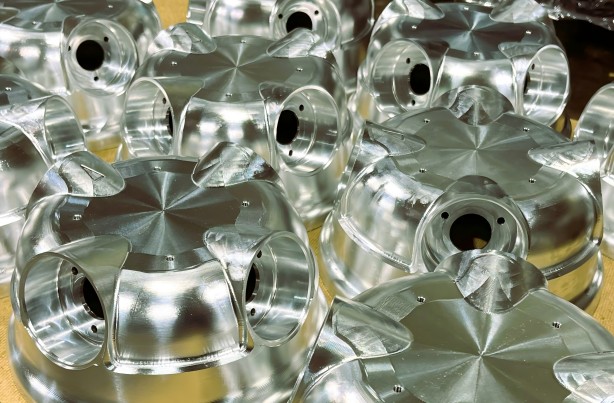The processing of the vehicle probe housing requires precision, durability and aesthetics. The following is its detailed processing technology:

Raw material selection
Select the appropriate raw materials according to the performance requirements of the probe housing. Common materials include engineering plastics, such as ABS, PC, with good formability, mechanical properties and weather resistance; Metal materials, such as aluminum alloy and magnesium alloy, have high strength, good heat dissipation and impact resistance.
Mold design and manufacturing
1. Mold design: According to the shape, size and functional requirements of the vehicle probe, the use of CAD/CAM technology for mold design. Determine the structure and parameters of key parts of the mold, such as parting surface, pouring system, cooling system and demoulding mechanism.
2. Mold manufacturing: CNC machining center, EDM machine tools and other advanced equipment for mold manufacturing. Precision machining of each part of the mold to ensure that its dimensional accuracy, shape accuracy and surface roughness meet the design requirements. In the process of mold manufacturing, the coordinate measuring instrument and other testing equipment are used to detect and control the processing accuracy of mold parts in real time to ensure the manufacturing quality of the mold.
Forming process
1. Injection molding (for plastic shell) : the selected plastic raw material is added to the cylinder of the injection molding machine, and the plastic raw material is melted by heating. Driven by the screw of the injection molding machine, the molten plastic is injected into the closed mold cavity at a certain pressure and speed. After filling the cavity, it is kept under a certain pressure for a period of time to cool and finalize the plastic in the cavity. After the cooling is complete, the mold is opened and the molded plastic shell is ejected from the mold through the ejector device.
2. Die casting molding (for metal shell) : The melted liquid metal is injected into the cavity of the die casting mold through the injection device at high speed and high pressure. The liquid metal quickly cools and solidifies in the cavity to form the desired shape of the metal shell. After die casting, the metal casing is ejected from the mold by an ejector.
Machining
The formed housing may require further machining to meet accuracy and assembly requirements:
1. Turning: It is used to process the round surface, end face and inner hole of the shell to improve its dimensional accuracy and surface quality.
2. Milling processing: the surface of various shapes such as the plane, step, groove, cavity and surface of the shell can be processed to meet the structural and functional requirements of the shell.
3. Drilling: Machining holes of various diameters on the shell for installing connectors such as screws, bolts, nuts, and internal components such as sensors and circuit boards.
Surface treatment
In order to improve the corrosion resistance, we ar resistance, aesthetics and functionality of the enclosure, surface treatment is required:
1. Spraying: Spraying paint of various colors and properties on the surface of the shell to form a uniform protective film, which plays the role of decoration, anti-corrosion, wear-resistant and heat insulation.
2. Electroplating: depositing a layer of metal or alloy coating on the surface of the shell by electrochemical method, such as chrome plating, zinc plating, nickel plating, etc., to improve the corrosion resistance, wear resistance, electrical conductivity and decoration of the shell.
3. Oxidation treatment: Form a dense oxide film on the surface of the shell, such as anodizing of aluminum alloy, bluing treatment of steel, etc., improve the corrosion resistance, wear resistance and insulation of the shell, and also obtain a certain decorative effect.
Quality inspection
1. Appearance detection: Visually or with magnifying glass, microscope and other tools, detect whether there are scratches, bumps, deformation, bubbles, impurities, cracks and other defects on the surface of the shell, and whether the color, luster and texture of the shell meet the design requirements.
2. Dimensional accuracy detection: Use caliper, micrometer, height ruler, plug gauge, ring gauge and other general measuring tools, as well as coordinate measuring instrument, optical projector, image measuring instrument and other precision measuring equipment, to measure and detect the key dimensions of the shell, and determine whether the dimensional accuracy meets the design requirements and relevant standards.
3. Performance test: According to the material characteristics and use requirements of the shell, the corresponding performance testing is carried out. Such as mechanical properties testing (tensile strength, yield strength, elongation at break, hardness, impact toughness, etc.), corrosion resistance testing (salt spray test, wet heat test, atmospheric exposure test, etc.), wear resistance testing (wear test, friction coefficient measurement, etc.), high temperature resistance testing (thermal deformation temperature measurement, Vica softening point measurement, etc.), electrical performance testing (insulation resistance measurement, insulation resistance measurement, etc.) Dielectric strength measurement, dielectric loss factor measurement, etc.).
Packing and warehousing
The shell that has passed the quality inspection is packed according to its size, shape and transportation requirements. Materials such as cardboard boxes, plastic bags and bubble wrap are usually used to ensure that the shell is not damaged during transportation and storage. The packaged shell is placed neatly on the warehouse shelf according to the batch and model, and the corresponding identification and records are made to facilitate management and traceability.

Post time: Jan-15-2025
